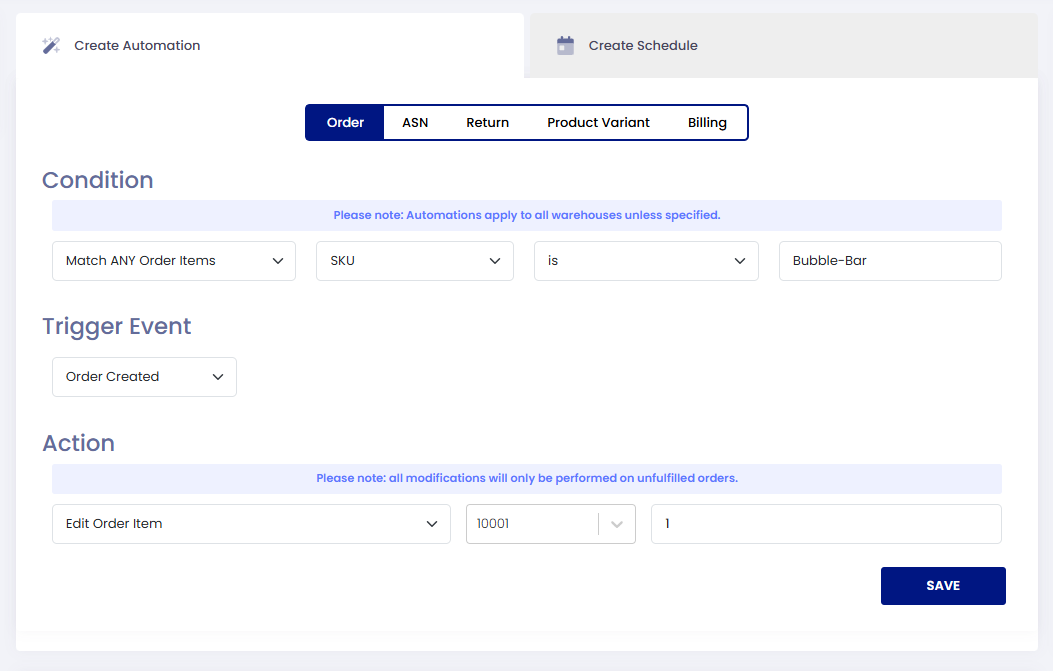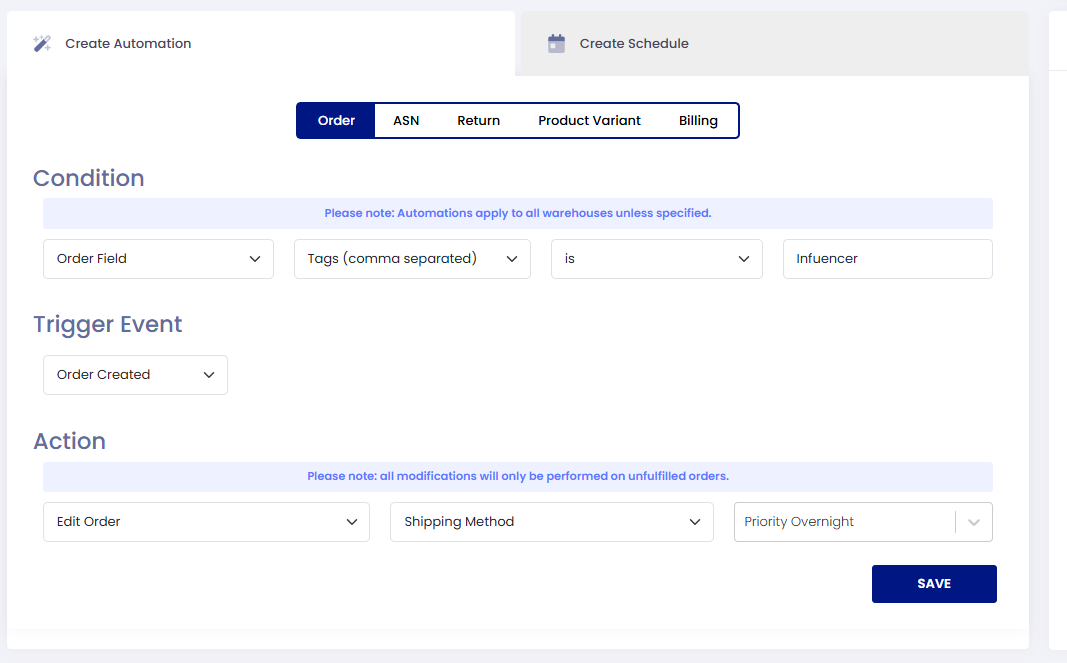We all know that running an ecommerce store isn’t easy. Brands not only have the pressure of creating new products and marketing them to the right audience, but also getting them to their customers safely (and cost-effectively!) at the end of the day.
Add the major growth that ecommerce has been seeing over the past few years, and you’ve got a huge amount of pressure for brands to deliver a seamless experience every time. A tall ask when order volume is scaling.
The solution? Ecommerce automation. With all the operational complexities that occur during the ecommerce fulfillment journey, it’s no wonder brands are turning to automation to do more with less.
Once reserved for retail giants, ecommerce automation is now readily available for high-growth direct-to-consumer brands. And they’re using it to scale with precision. For these brands, it means faster operations, smarter workflows, and (most importantly) happier customers.
Let’s dive in!
Why automation matters in ecommerce
There’s an increasing pressure on brands to move faster, fulfill more quickly, and support more distribution channels. Why? Because ecommerce competition is fierce, and customers aren’t as loyal as they once were. When brands fail to meet delivery timelines or provide personalized experiences, consumers may very well turn to one of their competitors.
And in a world where the customer experience trumps everything else, automation can be a handy tool to ensure a positive buying journey while avoiding bottlenecks that manual processes tend to create.
By the numbers:
- 90% of customers state that an immediate response is ‘very important’ when talking with support.
- Ecommerce retailers that implemented ecommerce automation saw ROI increase by 45% and qualified leads increase by 80%.
- The global warehouse automation market is expected to reach $41 billion in 2027.
Ecommerce automation helps cut through complexity. It takes repetitive, time-sensitive, and error-prone tasks off a retailer’s plate so they can focus on what actually moves the needle—building your brand.
The benefits of ecommerce automation
Time and cost savings
Time is just as valuable as money! When you’re a growing ecommerce brand, this couldn’t be more true. The more time a brand spends on repetitive tasks and managing operations, the less time they have to focus on growth.
Automating processes dramatically reduces the need for manual input across the board, whether it be order fulfillment, customer support, or inventory management. Plus, the ability to automate tasks reduces the risk of burnout, enabling your team to get more done with fewer resources.
Hassle-free integrations
Automation shouldn’t be siloed. In fact, it should enable talking between different systems, whether it be your Shopify storefront, your WMS, or your email marketing tool. The best automation tools are built to integrate seamlessly with your current tech stack. That means faster onboarding, fewer data silos, and no need to reinvent your workflows.
For example, your third-party logistics partner should have fulfillment technology that integrates directly with your Shopify account so that when orders come in, the warehouse can start working on picking, packing, and shipping products as soon as possible.
Reduced human error
Manual order routing, juggling spreadsheets, or toggling between systems often lead to mistakes like wrong shipments, missed delivery times, and costly returns…especially as order volumes grow.
Automation significantly reduces these risks by enforcing consistent, logic-based workflows, even during peak demand periods. Whether assigning orders based on inventory availability or syncing stock levels across channels, automation follows the rules every single time.
It’s a safety net for operational accuracy at scale. The result? Fewer fulfillment mistakes, lower return rates, and less time spent cleaning up after avoidable errors.
Better customer experience
Customer loyalty can be built through operational excellence. After all, reliable shipping, proactive updates, and fewer mishaps are the things that keep customers coming back. On the other hand, slow fulfillment, vague tracking, or hard-to-navigate returns can leave a bad impression, no matter how great the product is.
Automation helps enable an experience that feels effortless on the customer’s end, even if it’s complex behind the scenes. Think: automated delivery notifications and proactive alerts, or real-time tracking updates. Automated workflows ensure orders are processed faster, with the right products, in the right place, at the right time.
Types of ecommerce automation
Rules-based automation
Rules-based automation is logic that uses ‘if-this-then-that’ conditions defined in advance. Essentially, you set rules based on known variables to provide specific outcomes.
Examples:
- If the order value is over $200, then ship via expedited service.
- If the SKU is ‘oversized,’ then route to a warehouse with special packaging.
- If a customer orders SKU #10010, add a promotional item.
Event-based automation
This type of automation is triggered by a specific event or action taken by a user or system. Think ‘order placed’ or ‘item returned’ events that kick off a workflow.
Examples:
- Send a shipping confirmation email when a label is created.
- Trigger an alert when an order is delayed by a carrier.
- Generate a return label when a return request is submitted.
Data-driven automation
Data-driven automation is powered by…well, the data: trends, thresholds, and real-time analytics. Based on live data inputs, the system will take action.
Examples:
- Restock top-selling SKUs when inventory dips below average weekly demand.
- Adjust order routing based on real-time warehouse capacity.
- Trigger promotional offers once customers reach a certain loyalty tier.
5 tasks ecommerce businesses can automate
Marketing efforts & email flows
Ecommerce marketing automation software unlocks sending the right message at the right time, without having to think too much about it. When set up properly, these flows work 24/7 to engage shoppers and drive repeat purchases without manual effort.
- Email sequences: Welcome flows, product education series, promotional emails, all delivered based on real-time behavior.
- Abandoned cart flows: Automatically email shoppers who left items in their cart. This can include personalized product reminders to nudge the sale forward.
- Post-purchase campaigns: This includes automated shipping/order tracking, thank-you emails, product care tips, upsells, or review requests.
Order routing
As you scale, where an order gets fulfilled from can make or break both speed and cost. With automation, routing decisions don’t have to be made manually. Ecommerce automation can define rules to send orders to the optimal location based on:
- Inventory levels (only route to warehouse locations with stock).
- Proximity to the customer (shorter distance = faster delivery).
- Customer tier (VIPs get priority shipping).
- SKU type (bulky or fragile items go to the warehouse best equipped to handle them).
Inventory management
Inventory issues are one of the fastest ways to frustrate customers and rack up costs. Whether inventory is running low or getting stale on the shelf, the right fulfillment automation tool will help retailers stay ahead of stock issues before they happen.
- Auto-replenishment triggers: Set reorder points based on SKU velocity and levels.
- Low-stock alerts: Get notified when inventory drops below a certain threshold.
- Channel syncing: Keep product availability consistent across platforms to avoid overselling or stockouts.
Customer relationship management
Support teams often deal with the fallout from operational issues. Automation helps lighten the load so they can focus on higher-impact conversations. Customer service automation software should be able to:
- Auto-tag tickets by order status (e.g., delayed, returned, missing item).
- Route inquiries to the right team or rep based on the issue.
- Trigger instant responses for common requests.
Returns Processing
Returns are unavoidable. But, the good news is that ecommerce automation software can turn the entire process into a smoother experience for both brands and their customers.
- Auto-approve returns based on predefined rules (item type, order value, return window).
- Instantly generate shipping labels without manual back-and-forth.
- Automatically update inventory and restock once an item is scanned back in.
When it’s time to leverage automation tools in ecommerce
It’s never a bad time to start automating your fulfillment. Whether you’re shipping out 500 or 50,000 orders per month, automation enables more efficient workflows and fewer mistakes. Plus, it gives you time back, arguably one of the most important things when scaling an ecommerce business!
Look into ecommerce automation if you’re:
- Struggling to keep up with order volume
- Noticing more errors or delays
- Seeing a spike in customer support due to fulfillment mishaps
- Spending too much time manually routing orders
- Scaling your SKU base or warehouse network
Introducing Kase Automations: Scaling smarter
With Kase’s new rules-based automation feature, you can streamline your fulfillment operations with precision and control. Easily route orders based on logic you define, reduce manual touchpoints, and speed up delivery—all from a user-friendly interface. From bulk shipping upgrades to automatically adding, removing, or modifying products across orders, ASNs, and returns—our automation tools give you full control, without the manual lift.
What do Kase Automations look like?
Advanced Shipping Methods
Bulk Edit Orders: Easily update shipping methods for groups of orders with Automations:
- Condition: Filter orders created within the last two days.
- Trigger: Select “Now” to manually run those changes on existing orders.
- Action: Edit the shipping method (e.g., update to “Overnight Shipping” for all qualifying orders).
Advanced Order Routing
Smart Warehouse Selection: Automate warehouse assignment based on proximity and stock availability:
- Condition: Apply the rule to all orders.
- Trigger: Select “Now” to reassign the warehouse as soon as inventory has become available.
- Action: Select the warehouse with available inventory.
Advanced Shipping Characteristics
White Glove Service: Ensure premium handling for high-value orders:
- Condition: Target orders with a total price over $500.
- Trigger: Apply the rule when an order is first created.
- Action: Add “Signature Required” to the shipping details for premium orders.
Advanced Packaging and Promo Rules:
Enhance the customer experience with tailored packaging and promo rules:
- Condition: Identify specific SKUs (e.g., fragile items like “vase”).
- Trigger: Apply packaging rules immediately upon order creation.
- Action: Add additional promo items such as void fill and fragile tape.
Kase Automation Examples
Promotional items

If a client wants to automatically include a promotional item with certain orders, they can set up a rule based on the SKU of an item in the order. For example, if an order contains the SKU “Bubble-Bar,” the automation would trigger when the order is created and automatically edit the order to include the designated promotional item. The promo item will be added to the order as a separate line item, typically at the end of the packing list.
Shipping rules

This automation is useful for handling influencer orders that require expedited shipping. By tagging the order with “Influencer,” the workflow is triggered upon order creation and automatically updates the shipping method to Priority Overnight. This ensures VIP or influencer packages are prioritized without any manual intervention.
Want to learn more about the Kase fulfillment platform? Get in touch with one of our fulfillment experts today to book a demo.


